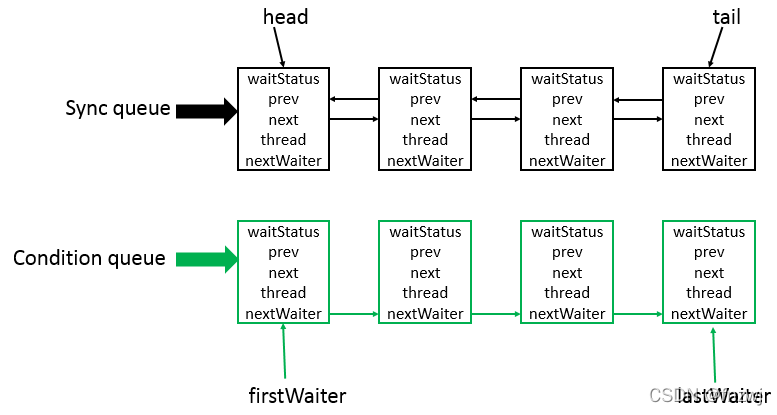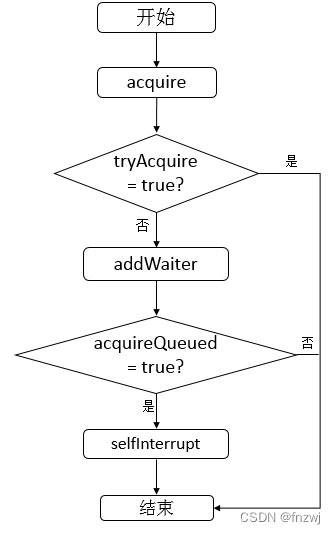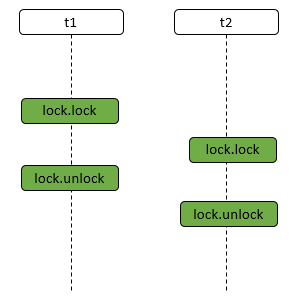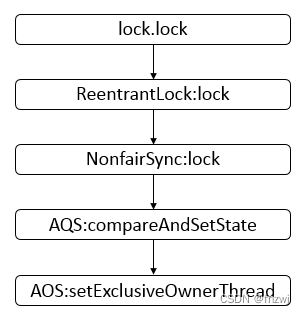一、AQS简介
AQS(AbstractQueuedSynchronizer)是一个用来构建锁和同步器的框架,使用AQS能简单且高效地构造出应用广泛的大量的同步器,比如我们提到的ReentrantLock,Semaphore,其他的诸如ReentrantReadWriteLock,SynchronousQueue,FutureTask等等皆是基于AQS的。当然,我们自己也能利用AQS非常轻松容易地构造出符合我们自己需求的同步器.
1、AQS的核心思想
AQS核心思想是,(1)如果被请求的共享资源空闲,则将当前请求资源的线程设置为有效的工作线程,并且将共享资源设置为锁定状态。(2)如果被请求的共享资源被占用,那么就需要一套线程阻塞等待以及被唤醒时锁分配的机制,这个机制AQS是用CLH队列锁实现的,即将暂时获取不到锁的线程加入到队列中。
CLH(Craig,Landin,and Hagersten)队列是一个虚拟的双向队列(虚拟的双向队列即不存在队列实例,仅存在结点之间的关联关系)。AQS是将每条请求共享资源的线程封装成一个CLH锁队列的一个结点(Node)来实现锁的分配。
AQS使用一个int成员变量来表示同步状态,通过内置的FIFO队列来完成获取资源线程的排队工作。AQS使用CAS对该同步状态进行原子操作实现对其值的修改。
private volatile int state;//共享变量,使用volatile修饰保证线程可见性
状态信息通过procted类型的getState,setState,compareAndSetState进行操作
//返回同步状态的当前值
protected final int getState() {
return state;
}
// 设置同步状态的值
protected final void setState(int newState) {
state = newState;
}
//原子地(CAS操作)将同步状态值设置为给定值update如果当前同步状态的值等于expect(期望值)
protected final boolean compareAndSetState(int expect, int update) {
return unsafe.compareAndSwapInt(this, stateOffset, expect, update);
}
2、AQS对资源的共享方式
AQS定义两种资源共享方式
-
Exclusive(独占):只有一个线程能执行,如
ReentrantLock。又可分为公平锁和非公平锁:- 公平锁:按照线程在队列中的排队顺序,先到者先拿到锁
- 非公平锁:当线程要获取锁时,无视队列顺序直接去抢锁,谁抢到就是谁的
-
Share(共享):多个线程可同时执行,如
Semaphore/CountDownLatch。Semaphore、CountDownLatCh、CyclicBarrier、ReadWriteLock我们会在工具类中讲到
3、AQS底层使用了模板方法模式
模板方法模式(Template pattern)(24种设计模式之一): 在一个方法中定义一个算法的骨架, 而将一些步骤延迟到子类中. 模板方法使得子类可以在不改变算法结构的情况下, 重新定义算法中的某些步骤.
同步器的设计是基于模板方法模式的,如果需要自定义同步器一般的方式是这样(模板方法模式很经典的一个应用): 使用者继承AbstractQueuedSynchronizer并重写指定的方法。(这些重写方法很简单,无非是对于共享资源state的获取和释放),将AQS组合在自定义同步组件的实现中,并调用其模板方法,而这些模板方法会调用使用者重写的方法。
AQS使用了模板方法模式,自定义同步器时需要重写下面几个AQS提供的模板方法:
isHeldExclusively()//该线程是否正在独占资源。只有用到condition才需要去实现它。
tryAcquire(int)//独占方式。尝试获取资源,成功则返回true,失败则返回false。
tryRelease(int)//独占方式。尝试释放资源,成功则返回true,失败则返回false。
tryAcquireShared(int)//共享方式。尝试获取资源。负数表示失败;0表示成功,但没有剩余可用资源;正数表示成功,且有剩余资源。
tryReleaseShared(int)//共享方式。尝试释放资源,成功则返回true,失败则返回false。
以ReentrantLock为例,state初始化为0,表示未锁定状态。A线程lock()时,会调用tryAcquire()独占该锁并将state+1。此后,其他线程再tryAcquire()时就会失败,直到A线程unlock()到state=0(即释放锁)为止,其它线程才有机会获取该锁。当然,释放锁之前,A线程自己是可以重复获取此锁的(state会累加),这就是可重入的概念。但要注意,获取多少次就要释放多么次,这样才能保证state是能回到零态的。
二、AQS的数据结构
AbstractQueuedSynchronizer类底层的数据结构是使用CLH(Craig,Landin,and Hagersten)队列是一个虚拟的双向队列(虚拟的双向队列即不存在队列实例,仅存在结点之间的关联关系)。AQS是将每条请求共享资源的线程封装成一个CLH锁队列的一个结点(Node)来实现锁的分配。其中Sync queue,即同步队列,是双向链表,包括head结点和tail结点,head结点主要用作后续的调度。而Condition queue不是必须的,其是一个单向链表,只有当使用Condition时,才会存在此单向链表。并且可能会有多个Condition queue。

三、AQS源码分析
1、AQS的继承关系
AbstractQueuedSynchronizer继承自AbstractOwnableSynchronizer抽象类,并且实现了Serializable接口,可以进行序列化。
public abstract class AbstractQueuedSynchronizer extends AbstractOwnableSynchronizer implements java.io.Serializable
其中AbstractOwnableSynchronizer抽象类的源码如下:
public abstract class AbstractOwnableSynchronizer implements java.io.Serializable {
// 版本序列号
private static final long serialVersionUID = 3737899427754241961L;
// 构造方法
protected AbstractOwnableSynchronizer() { }
// 独占模式下的线程
private transient Thread exclusiveOwnerThread;
// 设置独占线程
protected final void setExclusiveOwnerThread(Thread thread) {
exclusiveOwnerThread = thread;
}
// 获取独占线程
protected final Thread getExclusiveOwnerThread() {
return exclusiveOwnerThread;
}
}
AbstractOwnableSynchronizer抽象类中,可以设置独占资源线程和获取独占资源线程。分别为setExclusiveOwnerThread与getExclusiveOwnerThread方法,这两个方法会被子类调用。
2、AQS的内部类
AbstractQueuedSynchronizer类有两个内部类,分别为Node类与ConditionObject类。
2.1、Node类
static final class Node {
// 模式,分为共享与独占
// 共享模式
static final Node SHARED = new Node();
// 独占模式
static final Node EXCLUSIVE = null;
// 结点状态
// CANCELLED,值为1,表示当前的线程被取消
// SIGNAL,值为-1,表示当前节点的后继节点包含的线程需要运行,也就是unpark
// CONDITION,值为-2,表示当前节点在等待condition,也就是在condition队列中
// PROPAGATE,值为-3,表示当前场景下后续的acquireShared能够得以执行
// 值为0,表示当前节点在sync队列中,等待着获取锁
static final int CANCELLED = 1;
static final int SIGNAL = -1;
static final int CONDITION = -2;
static final int PROPAGATE = -3;
// 结点状态
volatile int waitStatus;
// 前驱结点
volatile Node prev;
// 后继结点
volatile Node next;
// 结点所对应的线程
volatile Thread thread;
// 下一个等待者
Node nextWaiter;
// 结点是否在共享模式下等待
final boolean isShared() {
return nextWaiter == SHARED;
}
// 获取前驱结点,若前驱结点为空,抛出异常
final Node predecessor() throws NullPointerException {
// 保存前驱结点
Node p = prev;
if (p == null) // 前驱结点为空,抛出异常
throw new NullPointerException();
else // 前驱结点不为空,返回
return p;
}
// 无参构造方法
Node() { // Used to establish initial head or SHARED marker
}
// 构造方法
Node(Thread thread, Node mode) { // Used by addWaiter
this.nextWaiter = mode;
this.thread = thread;
}
// 构造方法
Node(Thread thread, int waitStatus) { // Used by Condition
this.waitStatus = waitStatus;
this.thread = thread;
}
}
每个线程被阻塞的线程都会被封装成一个Node结点,放入队列。每个节点包含了一个Thread类型的引用,并且每个节点都存在一个状态,具体状态如下。
- CANCELLED,值为1,表示当前的线程被取消。 值为0,表示当前节点在sync queue中,等待着获取锁
- SIGNAL,值为-1,表示当前节点的后继节点包含的线程需要运行,需要进行unpark操作。
- CONDITION,值为-2,表示当前节点在等待condition,也就是在condition queue中。
- PROPAGATE,值为-3,表示当前场景下后续的acquireShared能够得以执行。
2.2、CondionObject类
// 内部类
public class ConditionObject implements Condition, java.io.Serializable {
// 版本号
private static final long serialVersionUID = 1173984872572414699L;
/** First node of condition queue. */
// condition队列的头节点
private transient Node firstWaiter;
/** Last node of condition queue. */
// condition队列的尾结点
private transient Node lastWaiter;
/**
* Creates a new {@code ConditionObject} instance.
*/
// 构造方法
public ConditionObject() { }
// Internal methods
/**
* Adds a new waiter to wait queue.
* @return its new wait node
*/
// 添加新的waiter到wait队列
private Node addConditionWaiter() {
// 保存尾结点
Node t = lastWaiter;
// If lastWaiter is cancelled, clean out.
if (t != null && t.waitStatus != Node.CONDITION) { // 尾结点不为空,并且尾结点的状态不为CONDITION
// 清除状态为CONDITION的结点
unlinkCancelledWaiters();
// 将最后一个结点重新赋值给t
t = lastWaiter;
}
// 新建一个结点
Node node = new Node(Thread.currentThread(), Node.CONDITION);
if (t == null) // 尾结点为空
// 设置condition队列的头节点
firstWaiter = node;
else // 尾结点不为空
// 设置为节点的nextWaiter域为node结点
t.nextWaiter = node;
// 更新condition队列的尾结点
lastWaiter = node;
return node;
}
/**
* Removes and transfers nodes until hit non-cancelled one or
* null. Split out from signal in part to encourage compilers
* to inline the case of no waiters.
* @param first (non-null) the first node on condition queue
*/
private void doSignal(Node first) {
// 循环
do {
if ( (firstWaiter = first.nextWaiter) == null) // 该节点的nextWaiter为空
// 设置尾结点为空
lastWaiter = null;
// 设置first结点的nextWaiter域
first.nextWaiter = null;
} while (!transferForSignal(first) &&
(first = firstWaiter) != null); // 将结点从condition队列转移到sync队列失败并且condition队列中的头节点不为空,一直循环
}
/**
* Removes and transfers all nodes.
* @param first (non-null) the first node on condition queue
*/
private void doSignalAll(Node first) {
// condition队列的头节点尾结点都设置为空
lastWaiter = firstWaiter = null;
// 循环
do {
// 获取first结点的nextWaiter域结点
Node next = first.nextWaiter;
// 设置first结点的nextWaiter域为空
first.nextWaiter = null;
// 将first结点从condition队列转移到sync队列
transferForSignal(first);
// 重新设置first
first = next;
} while (first != null);
}
/**
* Unlinks cancelled waiter nodes from condition queue.
* Called only while holding lock. This is called when
* cancellation occurred during condition wait, and upon
* insertion of a new waiter when lastWaiter is seen to have
* been cancelled. This method is needed to avoid garbage
* retention in the absence of signals. So even though it may
* require a full traversal, it comes into play only when
* timeouts or cancellations occur in the absence of
* signals. It traverses all nodes rather than stopping at a
* particular target to unlink all pointers to garbage nodes
* without requiring many re-traversals during cancellation
* storms.
*/
// 从condition队列中清除状态为CANCEL的结点
private void unlinkCancelledWaiters() {
// 保存condition队列头节点
Node t = firstWaiter;
Node trail = null;
while (t != null) { // t不为空
// 下一个结点
Node next = t.nextWaiter;
if (t.waitStatus != Node.CONDITION) { // t结点的状态不为CONDTION状态
// 设置t节点的nextWaiter域为空
t.nextWaiter = null;
if (trail == null) // trail为空
// 重新设置condition队列的头节点
firstWaiter = next;
else // trail不为空
// 设置trail结点的nextWaiter域为next结点
trail.nextWaiter = next;
if (next == null) // next结点为空
// 设置condition队列的尾结点
lastWaiter = trail;
}
else // t结点的状态为CONDTION状态
// 设置trail结点
trail = t;
// 设置t结点
t = next;
}
}
// public methods
/**
* Moves the longest-waiting thread, if one exists, from the
* wait queue for this condition to the wait queue for the
* owning lock.
*
* @throws IllegalMonitorStateException if {@link #isHeldExclusively}
* returns {@code false}
*/
// 唤醒一个等待线程。如果所有的线程都在等待此条件,则选择其中的一个唤醒。在从 await 返回之前,该线程必须重新获取锁。
public final void signal() {
if (!isHeldExclusively()) // 不被当前线程独占,抛出异常
throw new IllegalMonitorStateException();
// 保存condition队列头节点
Node first = firstWaiter;
if (first != null) // 头节点不为空
// 唤醒一个等待线程
doSignal(first);
}
/**
* Moves all threads from the wait queue for this condition to
* the wait queue for the owning lock.
*
* @throws IllegalMonitorStateException if {@link #isHeldExclusively}
* returns {@code false}
*/
// 唤醒所有等待线程。如果所有的线程都在等待此条件,则唤醒所有线程。在从 await 返回之前,每个线程都必须重新获取锁。
public final void signalAll() {
if (!isHeldExclusively()) // 不被当前线程独占,抛出异常
throw new IllegalMonitorStateException();
// 保存condition队列头节点
Node first = firstWaiter;
if (first != null) // 头节点不为空
// 唤醒所有等待线程
doSignalAll(first);
}
/**
* Implements uninterruptible condition wait.
* <ol>
* <li> Save lock state returned by {@link #getState}.
* <li> Invoke {@link #release} with saved state as argument,
* throwing IllegalMonitorStateException if it fails.
* <li> Block until signalled.
* <li> Reacquire by invoking specialized version of
* {@link #acquire} with saved state as argument.
* </ol>
*/
// 等待,当前线程在接到信号之前一直处于等待状态,不响应中断
public final void awaitUninterruptibly() {
// 添加一个结点到等待队列
Node node = addConditionWaiter();
// 获取释放的状态
int savedState = fullyRelease(node);
boolean interrupted = false;
while (!isOnSyncQueue(node)) { //
// 阻塞当前线程
LockSupport.park(this);
if (Thread.interrupted()) // 当前线程被中断
// 设置interrupted状态
interrupted = true;
}
if (acquireQueued(node, savedState) || interrupted) //
selfInterrupt();
}
/*
* For interruptible waits, we need to track whether to throw
* InterruptedException, if interrupted while blocked on
* condition, versus reinterrupt current thread, if
* interrupted while blocked waiting to re-acquire.
*/
/** Mode meaning to reinterrupt on exit from wait */
private static final int REINTERRUPT = 1;
/** Mode meaning to throw InterruptedException on exit from wait */
private static final int THROW_IE = -1;
/**
* Checks for interrupt, returning THROW_IE if interrupted
* before signalled, REINTERRUPT if after signalled, or
* 0 if not interrupted.
*/
private int checkInterruptWhileWaiting(Node node) {
return Thread.interrupted() ?
(transferAfterCancelledWait(node) ? THROW_IE : REINTERRUPT) :
0;
}
/**
* Throws InterruptedException, reinterrupts current thread, or
* does nothing, depending on mode.
*/
private void reportInterruptAfterWait(int interruptMode)
throws InterruptedException {
if (interruptMode == THROW_IE)
throw new InterruptedException();
else if (interruptMode == REINTERRUPT)
selfInterrupt();
}
/**
* Implements interruptible condition wait.
* <ol>
* <li> If current thread is interrupted, throw InterruptedException.
* <li> Save lock state returned by {@link #getState}.
* <li> Invoke {@link #release} with saved state as argument,
* throwing IllegalMonitorStateException if it fails.
* <li> Block until signalled or interrupted.
* <li> Reacquire by invoking specialized version of
* {@link #acquire} with saved state as argument.
* <li> If interrupted while blocked in step 4, throw InterruptedException.
* </ol>
*/
// // 等待,当前线程在接到信号或被中断之前一直处于等待状态
public final void await() throws InterruptedException {
if (Thread.interrupted()) // 当前线程被中断,抛出异常
throw new InterruptedException();
// 在wait队列上添加一个结点
Node node = addConditionWaiter();
//
int savedState = fullyRelease(node);
int interruptMode = 0;
while (!isOnSyncQueue(node)) {
// 阻塞当前线程
LockSupport.park(this);
if ((interruptMode = checkInterruptWhileWaiting(node)) != 0) // 检查结点等待时的中断类型
break;
}
if (acquireQueued(node, savedState) && interruptMode != THROW_IE)
interruptMode = REINTERRUPT;
if (node.nextWaiter != null) // clean up if cancelled
unlinkCancelledWaiters();
if (interruptMode != 0)
reportInterruptAfterWait(interruptMode);
}
/**
* Implements timed condition wait.
* <ol>
* <li> If current thread is interrupted, throw InterruptedException.
* <li> Save lock state returned by {@link #getState}.
* <li> Invoke {@link #release} with saved state as argument,
* throwing IllegalMonitorStateException if it fails.
* <li> Block until signalled, interrupted, or timed out.
* <li> Reacquire by invoking specialized version of
* {@link #acquire} with saved state as argument.
* <li> If interrupted while blocked in step 4, throw InterruptedException.
* </ol>
*/
// 等待,当前线程在接到信号、被中断或到达指定等待时间之前一直处于等待状态
public final long awaitNanos(long nanosTimeout)
throws InterruptedException {
if (Thread.interrupted())
throw new InterruptedException();
Node node = addConditionWaiter();
int savedState = fullyRelease(node);
final long deadline = System.nanoTime() + nanosTimeout;
int interruptMode = 0;
while (!isOnSyncQueue(node)) {
if (nanosTimeout <= 0L) {
transferAfterCancelledWait(node);
break;
}
if (nanosTimeout >= spinForTimeoutThreshold)
LockSupport.parkNanos(this, nanosTimeout);
if ((interruptMode = checkInterruptWhileWaiting(node)) != 0)
break;
nanosTimeout = deadline - System.nanoTime();
}
if (acquireQueued(node, savedState) && interruptMode != THROW_IE)
interruptMode = REINTERRUPT;
if (node.nextWaiter != null)
unlinkCancelledWaiters();
if (interruptMode != 0)
reportInterruptAfterWait(interruptMode);
return deadline - System.nanoTime();
}
/**
* Implements absolute timed condition wait.
* <ol>
* <li> If current thread is interrupted, throw InterruptedException.
* <li> Save lock state returned by {@link #getState}.
* <li> Invoke {@link #release} with saved state as argument,
* throwing IllegalMonitorStateException if it fails.
* <li> Block until signalled, interrupted, or timed out.
* <li> Reacquire by invoking specialized version of
* {@link #acquire} with saved state as argument.
* <li> If interrupted while blocked in step 4, throw InterruptedException.
* <li> If timed out while blocked in step 4, return false, else true.
* </ol>
*/
// 等待,当前线程在接到信号、被中断或到达指定最后期限之前一直处于等待状态
public final boolean awaitUntil(Date deadline)
throws InterruptedException {
long abstime = deadline.getTime();
if (Thread.interrupted())
throw new InterruptedException();
Node node = addConditionWaiter();
int savedState = fullyRelease(node);
boolean timedout = false;
int interruptMode = 0;
while (!isOnSyncQueue(node)) {
if (System.currentTimeMillis() > abstime) {
timedout = transferAfterCancelledWait(node);
break;
}
LockSupport.parkUntil(this, abstime);
if ((interruptMode = checkInterruptWhileWaiting(node)) != 0)
break;
}
if (acquireQueued(node, savedState) && interruptMode != THROW_IE)
interruptMode = REINTERRUPT;
if (node.nextWaiter != null)
unlinkCancelledWaiters();
if (interruptMode != 0)
reportInterruptAfterWait(interruptMode);
return !timedout;
}
/**
* Implements timed condition wait.
* <ol>
* <li> If current thread is interrupted, throw InterruptedException.
* <li> Save lock state returned by {@link #getState}.
* <li> Invoke {@link #release} with saved state as argument,
* throwing IllegalMonitorStateException if it fails.
* <li> Block until signalled, interrupted, or timed out.
* <li> Reacquire by invoking specialized version of
* {@link #acquire} with saved state as argument.
* <li> If interrupted while blocked in step 4, throw InterruptedException.
* <li> If timed out while blocked in step 4, return false, else true.
* </ol>
*/
// 等待,当前线程在接到信号、被中断或到达指定等待时间之前一直处于等待状态。此方法在行为上等效于: awaitNanos(unit.toNanos(time)) > 0
public final boolean await(long time, TimeUnit unit)
throws InterruptedException {
long nanosTimeout = unit.toNanos(time);
if (Thread.interrupted())
throw new InterruptedException();
Node node = addConditionWaiter();
int savedState = fullyRelease(node);
final long deadline = System.nanoTime() + nanosTimeout;
boolean timedout = false;
int interruptMode = 0;
while (!isOnSyncQueue(node)) {
if (nanosTimeout <= 0L) {
timedout = transferAfterCancelledWait(node);
break;
}
if (nanosTimeout >= spinForTimeoutThreshold)
LockSupport.parkNanos(this, nanosTimeout);
if ((interruptMode = checkInterruptWhileWaiting(node)) != 0)
break;
nanosTimeout = deadline - System.nanoTime();
}
if (acquireQueued(node, savedState) && interruptMode != THROW_IE)
interruptMode = REINTERRUPT;
if (node.nextWaiter != null)
unlinkCancelledWaiters();
if (interruptMode != 0)
reportInterruptAfterWait(interruptMode);
return !timedout;
}
// support for instrumentation
/**
* Returns true if this condition was created by the given
* synchronization object.
*
* @return {@code true} if owned
*/
final boolean isOwnedBy(AbstractQueuedSynchronizer sync) {
return sync == AbstractQueuedSynchronizer.this;
}
/**
* Queries whether any threads are waiting on this condition.
* Implements {@link AbstractQueuedSynchronizer#hasWaiters(ConditionObject)}.
*
* @return {@code true} if there are any waiting threads
* @throws IllegalMonitorStateException if {@link #isHeldExclusively}
* returns {@code false}
*/
// 查询是否有正在等待此条件的任何线程
protected final boolean hasWaiters() {
if (!isHeldExclusively())
throw new IllegalMonitorStateException();
for (Node w = firstWaiter; w != null; w = w.nextWaiter) {
if (w.waitStatus == Node.CONDITION)
return true;
}
return false;
}
/**
* Returns an estimate of the number of threads waiting on
* this condition.
* Implements {@link AbstractQueuedSynchronizer#getWaitQueueLength(ConditionObject)}.
*
* @return the estimated number of waiting threads
* @throws IllegalMonitorStateException if {@link #isHeldExclusively}
* returns {@code false}
*/
// 返回正在等待此条件的线程数估计值
protected final int getWaitQueueLength() {
if (!isHeldExclusively())
throw new IllegalMonitorStateException();
int n = 0;
for (Node w = firstWaiter; w != null; w = w.nextWaiter) {
if (w.waitStatus == Node.CONDITION)
++n;
}
return n;
}
/**
* Returns a collection containing those threads that may be
* waiting on this Condition.
* Implements {@link AbstractQueuedSynchronizer#getWaitingThreads(ConditionObject)}.
*
* @return the collection of threads
* @throws IllegalMonitorStateException if {@link #isHeldExclusively}
* returns {@code false}
*/
// 返回包含那些可能正在等待此条件的线程集合
protected final Collection<Thread> getWaitingThreads() {
if (!isHeldExclusively())
throw new IllegalMonitorStateException();
ArrayList<Thread> list = new ArrayList<Thread>();
for (Node w = firstWaiter; w != null; w = w.nextWaiter) {
if (w.waitStatus == Node.CONDITION) {
Thread t = w.thread;
if (t != null)
list.add(t);
}
}
return list;
}
}
此类实现了Condition接口,Condition接口定义了条件操作规范,具体如下
public interface Condition {
// 等待,当前线程在接到信号或被中断之前一直处于等待状态
void await() throws InterruptedException;
// 等待,当前线程在接到信号之前一直处于等待状态,不响应中断
void awaitUninterruptibly();
//等待,当前线程在接到信号、被中断或到达指定等待时间之前一直处于等待状态
long awaitNanos(long nanosTimeout) throws InterruptedException;
// 等待,当前线程在接到信号、被中断或到达指定等待时间之前一直处于等待状态。此方法在行为上等效于: awaitNanos(unit.toNanos(time)) > 0
boolean await(long time, TimeUnit unit) throws InterruptedException;
// 等待,当前线程在接到信号、被中断或到达指定最后期限之前一直处于等待状态
boolean awaitUntil(Date deadline) throws InterruptedException;
// 唤醒一个等待线程。如果所有的线程都在等待此条件,则选择其中的一个唤醒。在从 await 返回之前,该线程必须重新获取锁。
void signal();
// 唤醒所有等待线程。如果所有的线程都在等待此条件,则唤醒所有线程。在从 await 返回之前,每个线程都必须重新获取锁。
void signalAll();
}
Condition接口中定义了await、signal方法,用来等待条件、释放条件。之后会详细分析CondtionObject的源码
3、AQS的属性
属性中包含了头节点head,尾结点tail,状态state、自旋时间spinForTimeoutThreshold,还有AbstractQueuedSynchronizer抽象的属性在内存中的偏移地址,通过该偏移地址,可以获取和设置该属性的值,同时还包括一个静态初始化块,用于加载内存偏移地址。
public abstract class AbstractQueuedSynchronizer extends AbstractOwnableSynchronizer
implements java.io.Serializable {
// 版本号
private static final long serialVersionUID = 7373984972572414691L;
// 头节点
private transient volatile Node head;
// 尾结点
private transient volatile Node tail;
// 状态
private volatile int state;
// 自旋时间
static final long spinForTimeoutThreshold = 1000L;
// Unsafe类实例
private static final Unsafe unsafe = Unsafe.getUnsafe();
// state内存偏移地址
private static final long stateOffset;
// head内存偏移地址
private static final long headOffset;
// state内存偏移地址
private static final long tailOffset;
// tail内存偏移地址
private static final long waitStatusOffset;
// next内存偏移地址
private static final long nextOffset;
// 静态初始化块
static {
try {
stateOffset = unsafe.objectFieldOffset
(AbstractQueuedSynchronizer.class.getDeclaredField("state"));
headOffset = unsafe.objectFieldOffset
(AbstractQueuedSynchronizer.class.getDeclaredField("head"));
tailOffset = unsafe.objectFieldOffset
(AbstractQueuedSynchronizer.class.getDeclaredField("tail"));
waitStatusOffset = unsafe.objectFieldOffset
(Node.class.getDeclaredField("waitStatus"));
nextOffset = unsafe.objectFieldOffset
(Node.class.getDeclaredField("next"));
} catch (Exception ex) { throw new Error(ex); }
}
}
4、AQS的构造方法
此类构造方法为从抽象构造方法,供子类调用。
protected AbstractQueuedSynchronizer() { }
5、AQS的核心方法
51、acquire()方法
该方法以独占模式获取(资源),忽略中断,即线程在aquire过程中,中断此线程是无效的。源码如下:
public final void acquire(int arg) {
if (!tryAcquire(arg) && acquireQueued(addWaiter(Node.EXCLUSIVE), arg))
selfInterrupt();
}
由上述源码可以知道,当一个线程调用acquire时,调用方法流程如下

- 首先调用tryAcquire方法,调用此方法的线程会试图在独占模式下获取对象状态。此方法应该查询是否允许它在独占模式下获取对象状态,如果允许,则获取它。在AbstractQueuedSynchronizer源码中默认会抛出一个异常,即需要子类去重写此方法完成自己的逻辑。之后会进行分析。
- 若tryAcquire失败,则调用addWaiter方法,addWaiter方法完成的功能是将调用此方法的线程封装成为一个结点并放入Sync queue。
- 调用acquireQueued方法,此方法完成的功能是Sync queue中的结点不断尝试获取资源,若成功,则返回true,否则,返回false。
- 由于tryAcquire默认实现是抛出异常,所以此时,不进行分析,之后会结合一个例子进行分析。
首先分析addWaiter方法
// 添加等待者
private Node addWaiter(Node mode) {
// 新生成一个结点,默认为独占模式
Node node = new Node(Thread.currentThread(), mode);
// Try the fast path of enq; backup to full enq on failure
// 保存尾结点
Node pred = tail;
if (pred != null) { // 尾结点不为空,即已经被初始化
// 将node结点的prev域连接到尾结点
node.prev = pred;
if (compareAndSetTail(pred, node)) { // 比较pred是否为尾结点,是则将尾结点设置为node
// 设置尾结点的next域为node
pred.next = node;
return node; // 返回新生成的结点
}
}
enq(node); // 尾结点为空(即还没有被初始化过),或者是compareAndSetTail操作失败,则入队列
return node;
}
addWaiter方法使用快速添加的方式往sync queue尾部添加结点,如果sync queue队列还没有初始化,则会使用enq插入队列中,enq方法源码如下
private Node enq(final Node node) {
for (;;) { // 无限循环,确保结点能够成功入队列
// 保存尾结点
Node t = tail;
if (t == null) { // 尾结点为空,即还没被初始化
if (compareAndSetHead(new Node())) // 头节点为空,并设置头节点为新生成的结点
tail = head; // 头节点与尾结点都指向同一个新生结点
} else { // 尾结点不为空,即已经被初始化过
// 将node结点的prev域连接到尾结点
node.prev = t;
if (compareAndSetTail(t, node)) { // 比较结点t是否为尾结点,若是则将尾结点设置为node
// 设置尾结点的next域为node
t.next = node;
return t; // 返回尾结点
}
}
}
}
enq方法会使用无限循环来确保节点的成功插入。
现在,分析acquireQueue方法。其源码如下
// sync队列中的结点在独占且忽略中断的模式下获取(资源)
final boolean acquireQueued(final Node node, int arg) {
// 标志
boolean failed = true;
try {
// 中断标志
boolean interrupted = false;
for (;;) { // 无限循环
// 获取node节点的前驱结点
final Node p = node.predecessor();
if (p == head && tryAcquire(arg)) { // 前驱为头节点并且成功获得锁
setHead(node); // 设置头节点
p.next = null; // help GC
failed = false; // 设置标志
return interrupted;
}
if (shouldParkAfterFailedAcquire(p, node) &&
parkAndCheckInterrupt())
interrupted = true;
}
} finally {
if (failed)
cancelAcquire(node);
}
}
首先获取当前节点的前驱节点,如果前驱节点是头节点并且能够获取(资源),代表该当前节点能够占有锁,设置头节点为当前节点,返回。否则,调用shouldParkAfterFailedAcquire和parkAndCheckInterrupt方法,首先,我们看shouldParkAfterFailedAcquire方法,代码如下
// 当获取(资源)失败后,检查并且更新结点状态
private static boolean shouldParkAfterFailedAcquire(Node pred, Node node) {
// 获取前驱结点的状态
int ws = pred.waitStatus;
if (ws == Node.SIGNAL) // 状态为SIGNAL,为-1
/*
* This node has already set status asking a release
* to signal it, so it can safely park.
*/
// 可以进行park操作
return true;
if (ws > 0) { // 表示状态为CANCELLED,为1
/*
* Predecessor was cancelled. Skip over predecessors and
* indicate retry.
*/
do {
node.prev = pred = pred.prev;
} while (pred.waitStatus > 0); // 找到pred结点前面最近的一个状态不为CANCELLED的结点
// 赋值pred结点的next域
pred.next = node;
} else { // 为PROPAGATE -3 或者是0 表示无状态,(为CONDITION -2时,表示此节点在condition queue中)
/*
* waitStatus must be 0 or PROPAGATE. Indicate that we
* need a signal, but don't park yet. Caller will need to
* retry to make sure it cannot acquire before parking.
*/
// 比较并设置前驱结点的状态为SIGNAL
compareAndSetWaitStatus(pred, ws, Node.SIGNAL);
}
// 不能进行park操作
return false;
}
只有当该节点的前驱结点的状态为SIGNAL时,才可以对该结点所封装的线程进行park操作。否则,将不能进行park操作。再看parkAndCheckInterrupt方法,源码如下
// 进行park操作并且返回该线程是否被中断
private final boolean parkAndCheckInterrupt() {
// 在许可可用之前禁用当前线程,并且设置了blocker
LockSupport.park(this);
return Thread.interrupted(); // 当前线程是否已被中断,并清除中断标记位
}
parkAndCheckInterrupt方法里的逻辑是首先执行park操作,即禁用当前线程,然后返回该线程是否已经被中断。再看final块中的cancelAcquire方法,其源码如下
// 取消继续获取(资源)
private void cancelAcquire(Node node) {
// Ignore if node doesn't exist
// node为空,返回
if (node == null)
return;
// 设置node结点的thread为空
node.thread = null;
// Skip cancelled predecessors
// 保存node的前驱结点
Node pred = node.prev;
while (pred.waitStatus > 0) // 找到node前驱结点中第一个状态小于0的结点,即不为CANCELLED状态的结点
node.prev = pred = pred.prev;
// predNext is the apparent node to unsplice. CASes below will
// fail if not, in which case, we lost race vs another cancel
// or signal, so no further action is necessary.
// 获取pred结点的下一个结点
Node predNext = pred.next;
// Can use unconditional write instead of CAS here.
// After this atomic step, other Nodes can skip past us.
// Before, we are free of interference from other threads.
// 设置node结点的状态为CANCELLED
node.waitStatus = Node.CANCELLED;
// If we are the tail, remove ourselves.
if (node == tail && compareAndSetTail(node, pred)) { // node结点为尾结点,则设置尾结点为pred结点
// 比较并设置pred结点的next节点为null
compareAndSetNext(pred, predNext, null);
} else { // node结点不为尾结点,或者比较设置不成功
// If successor needs signal, try to set pred's next-link
// so it will get one. Otherwise wake it up to propagate.
int ws;
if (pred != head &&
((ws = pred.waitStatus) == Node.SIGNAL ||
(ws <= 0 && compareAndSetWaitStatus(pred, ws, Node.SIGNAL))) &&
pred.thread != null) { // (pred结点不为头节点,并且pred结点的状态为SIGNAL)或者
// pred结点状态小于等于0,并且比较并设置等待状态为SIGNAL成功,并且pred结点所封装的线程不为空
// 保存结点的后继
Node next = node.next;
if (next != null && next.waitStatus <= 0) // 后继不为空并且后继的状态小于等于0
compareAndSetNext(pred, predNext, next); // 比较并设置pred.next = next;
} else {
unparkSuccessor(node); // 释放node的前一个结点
}
node.next = node; // help GC
}
}
该方法完成的功能就是取消当前线程对资源的获取,即设置该结点的状态为CANCELLED,接着我们再看unparkSuccessor方法,源码如下
该方法的作用就是为了释放node节点的后继结点。
对于cancelAcquire与unparkSuccessor方法,如下示意图可以清晰的表示:

其中node为参数,在执行完cancelAcquire方法后的效果就是unpark了s结点所包含的t4线程。
现在,再来看acquireQueued方法的整个的逻辑。逻辑如下:
- 判断结点的前驱是否为head并且是否成功获取(资源)。
- 若步骤1均满足,则设置结点为head,之后会判断是否finally模块,然后返回。
- 若步骤2不满足,则判断是否需要park当前线程,是否需要park当前线程的逻辑是判断结点的前驱结点的状态是否为SIGNAL,若是,则park当前结点,否则,不进行park操作。
- 若park了当前线程,之后某个线程对本线程unpark后,并且本线程也获得机会运行。那么,将会继续进行步骤①的判断
5.2、release()方法
以独占模式释放对象,其源码如下:
public final boolean release(int arg) {
if (tryRelease(arg)) { // 释放成功
// 保存头节点
Node h = head;
if (h != null && h.waitStatus != 0) // 头节点不为空并且头节点状态不为0
unparkSuccessor(h); //释放头节点的后继结点
return true;
}
return false;
}
其中,tryRelease的默认实现是抛出异常,需要具体的子类实现,如果tryRelease成功,那么如果头节点不为空并且头节点的状态不为0,则释放头节点的后继结点,unparkSuccessor方法已经分析过,不再累赘。
四、AQS示例详解
1、测试用例
import java.util.concurrent.locks.Lock;
import java.util.concurrent.locks.ReentrantLock;
class MyThread extends Thread {
private Lock lock;
public MyThread(String name, Lock lock) {
super(name);
this.lock = lock;
}
public void run () {
lock.lock();
try {
System.out.println(Thread.currentThread().getName() + " running");
} finally {
lock.unlock();
}
}
}
public class AbstractQueuedSynchonizerDemo {
public static void main(String[] args) {
Lock lock = new ReentrantLock();
MyThread t1 = new MyThread("t1", lock);
MyThread t2 = new MyThread("t2", lock);
t1.start();
t2.start();
}
}
运行结果(可能的一种):
t1 running
t2 running
2、结果分析
从示例可知,线程t1与t2共用了一把锁,即同一个lock。可能会存在如下一种时序。

说明: 首先线程t1先执行lock.lock操作,然后t2执行lock.lock操作,然后t1执行lock.unlock操作,最后t2执行lock.unlock操作。基于这样的时序,分析AbstractQueuedSynchronizer内部的工作机制。
1、t1线程调用lock.lock方法,其方法调用顺序如下,只给出了主要的方法调用。

说明: 其中,前面的部分表示哪个类,后面是具体的类中的哪个方法,AQS表示AbstractQueuedSynchronizer类,AOS表示AbstractOwnableSynchronizer类。
2、t2线程调用lock.lock方法,其方法调用顺序如下,只给出了主要的方法调用。

说明: 经过一系列的方法调用,最后达到的状态是禁用t2线程,因为调用了LockSupport.park()。
3、t1线程调用lock.unlock,其方法调用顺序如下,只给出了主要的方法调用。

说明: t1线程中调用lock.unlock后,经过一系列的调用,最终的状态是释放了许可,因为调用了LockSupport.unpark。这时,t2线程就可以继续运行了。此时,会继续恢复t2线程运行环境,继续执行LockSupport.park后面的语句,即进一步调用如下。

说明: 在上一步调用了LockSupport.unpark后,t2线程恢复运行,则运行parkAndCheckInterrupt,之后,继续运行acquireQueued方法,最后达到的状态是头节点head与尾结点tail均指向了t2线程所在的结点,并且之前的头节点已经从sync队列中断开了。
4、t2线程调用lock.unlock,其方法调用顺序如下,只给出了主要的方法调用。

说明: t2线程执行lock.unlock后,最终达到的状态还是与之前的状态一样
五、AQS总结
对于AbstractQueuedSynchronizer的分析,最核心的就是sync queue的分析。
- 每一个结点都是由前一个结点唤醒 当结点发现前驱结点是head并且尝试获取成功,则会轮到该线程运行。
- condition queue中的结点向sync queue中转移是通过signal操作完成的。
- 当结点的状态为SIGNAL时,表示后面的结点需要运行
六、面试问题
1、什么是AQS? 为什么它是核心?
2、AQS的核心思想是什么? 它是怎么实现的? 底层数据结构等
3、AQS有哪些核心的方法?
4、 AQS定义什么样的资源获取方式?
AQS定义了两种资源获取方式:独占(只有一个线程能访问执行,又根据是否按队列的顺序分为公平锁和非公平锁,如ReentrantLock) 和共享(多个线程可同时访问执行,如Semaphore、CountDownLatch、 CyclicBarrier )。ReentrantReadWriteLock可以看成是组合式,允许多个线程同时对某一资源进行读。
5、AQS底层使用了什么样的设计模式?
模板
